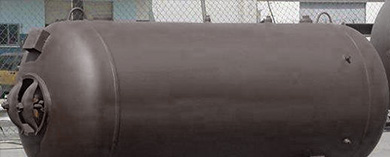
- (03) 5909 8218
- enquiry@fusionweld.com.au
Ferrous & Non-Ferrous Metals and their Uses in Pressure Vessels
May 19, 2014

This is a very complex topic and it can range over a number of angles from vessel creation to vessel recycling, standards, codes and usage as well as safety. In order to understand the application if ferrous and non-ferrous metals to pressure vessels one must first know what the three consists of.
First let’s examine non-ferrous metals. They are a bit more expensive than ferrous metals are, and they are used mainly because of the desirable properties that they possess. One is the light weight of a non-ferrous metal. They also portray a higher conductivity alongside being non-magnetic. Non-ferrous metals are very resistant to corrosion. Some non-ferrous metals are used widely throughout steel and iron industries.
Ferrous metals on the other hand are something totally different. The term outside of chemistry offers a strong indication of iron being present in the metal. Ferrous may include pig iron or steel and it is derived from the Latin term ferrum.
That brings us to pressure vessels. You see them every day when you open your medicine cabinet or pass by a plant. This can be in the form of an aerosol can or a huge gas storage vessel like you see in the refineries. They are designed to hold liquids or gases under differential pressure. Deferential pressure is far more risky to deal with than stabilized or regulated pressure. This is actually very dangerous pressure, and it has led to many catastrophic accidents. Consequently, the design of the pressure vessel, its operation and manufacturing are all engineer regulated processes with authorities that have been backed by legislation.
Most pressure vessels are made from the ferrous metal, steel. It has a plethora of welded together parts, and some of the parts can be affected by the welding process. For this reason it is vital that special precautions be taken and strict guidelines followed when working with the ferrous and nonferrous metals that make up the pressure vessel. The steel must be able to take high impact blows and maintain its integrity. This is especially true for pressure vessels that exist in low temperatures. They must be more than durable and very corrosion resistant.
There may be non-ferrous metals lining the pressure vessels to prevent leaks and also to add surface protection. This outer lining may also be responsible for carrying a portion of the load of pressure as well.
Again, these are things that you see every day. Your hot water tank may be a pressure vessel. Safety standards are set so high that we never give them seconds thought of how dangerous they would be if those set guidelines were not followed. The perfect storm of ferrous and non-ferrous metals coincide to make the pressure cylinders that we live and work with everyday a normal thing, and that is because the world as we know it would not be the same without them or the precious metals that create them.
Contact Details
Fusion - Weld Engineering Pty Ltd
ABN 98 068 987619
1865 Frankston Flinders Road,
Hastings, VIC 3915
Ph: (03) 5909 8218
Optimized by NetwizardSEO.com.au
Recent Posts
- Compressed Hydrogen Storage Vessels: Material Selection, Design & Australian Standards
- Welding QA/QC in Oil & Gas Pressure Vessel Fabrication – Ensuring Code Compliance
- AS1210 vs ASME VIII Pressure Vessel Code: Key Differences for Australian Projects
- Mitigating Hydrogen-Induced Cracking in Pressure Vessels: Engineering and Material Strategies
- Storage Tank Solutions Australia: Field-Erected, Prefabricated & Self-Bunded Explained
- Reducing Environmental Risks: Self-Bunded Tanks in Australian Oil & Gas Operations
- Precision in Production: How Pressure Vessels Are Manufactured for Industrial Safety
- Shell & Tube Heat Exchangers: Improve Thermal Control & Energy Recovery in Petrochemical & Pharmaceutical Plants
- In-Service Inspection for Compressed Air Receivers for Power Plant Shutdown Prevention
- Power Plant Pipe Spooling Fabrication – Get Rapid, Code-Compliant Spools Ready for Installation
- Field Erected Tanks: Safe, Reliable On-Site Fuel Storage Solutions in Australia
- Custom Pressure Vessel Fabrication for Flammable Gases
Posts 2025
- Compressed Hydrogen Storage Vessels: Material Selection, Design & Australian Standards
- Welding QA/QC in Oil & Gas Pressure Vessel Fabrication – Ensuring Code Compliance
- View all articles…
Posts 2024
- Large Process Vessels: Optimising the Design for Maximum Efficiency [2025]
- Pressure Equipment Management System Installation: Detect Equipment Faults Early
- View all articles…
Posts 2023
- Pressure Piping System Inspection: A Gift of Safety for the Holidays
- Deaerator Inspections by Fusion-Weld Engineering and How They Reduce System Downtime
- View all articles…
Posts 2022
- How Fusion Weld Keeps Up With AS-NZS ISO 9001:2008 Standard
- Boiler Equipment Safety Inspection During the Summer Season
- View all articles…
Posts 2021
- Avoid These Factors and Practices that Contribute to Sealing Damage in Pressure Vessels
- Do's And Don'ts Of Industrial Boiler Inspection And Maintenance From Fusion-Weld
- View all articles…
Posts 2020
- What are the Risks and Hazards Involved in Pressure Vessel Equipment?
- How to Know if Your Pressure Equipment Needs Repair or Replacement?
- View all articles…
Posts 2019
- Factors that Contribute to Pressure Vessel Failure
- Pressure Vessel Regulations in Australia: What are the Mandatory Requirements?
- View all articles…
Posts 2018
- Pros and Cons of Spherical vs. Cylindrical Pressure Vessels
- What are the Different Hazard Levels in Pressure Vessels?
- View all articles…
Posts 2017
- Transportable Pressure Vessels: The Importance of Inspection and Safety Checks
- Fracture Mechanics and Stress Analysis of Cracks in Pressure Vessels
- View all articles…
Posts 2016
Posts 2015
- What Are Deaerators & Feedwater Vessels?
- Precautions and Safety for Compressed Air Receiver Vessels
- View all articles…
Posts 2014
- Demonstrating In-process Inspection Procedures
- Static Grounding Practices and Standards
- View all articles…